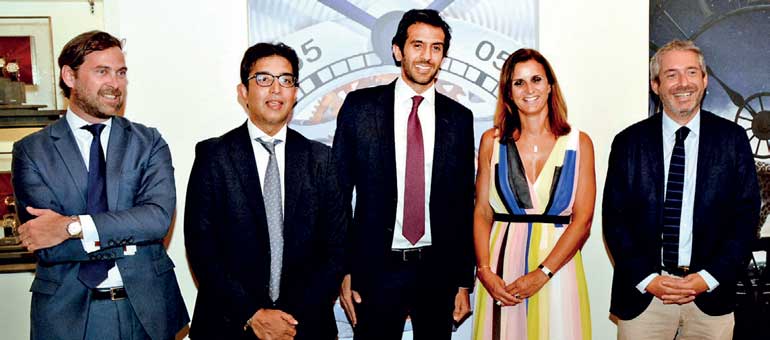Sunday Apr 20, 2025
Sunday Apr 20, 2025
Thursday, 14 September 2017 00:00 - - {{hitsCtrl.values.hits}}

By Madushka Balasuriya
Purchasing a luxury watch has always been a unique experience, and this feeling has only heightened in modern times. While advances in technology have meant that consumers are increasingly geared towards function over aesthetic, not even the advent of smartwatches have managed to dent the vibrancy of the luxury watch market.
“The difference between a smartwatch and a Cartier watch is meant to stand the test of time and the other is meant to be renewed regularly,” says Guillaume Alix by way of an explanation.
“We want to create timeless watches. The idea is really to have watches that you will be able to pass over to the next generation, and that your son or daughter is going to be proud of, which is very demanding. It demands a lot of thinking process, a lot of design, a lot of internal debate, you know, about the launch of each new watch,” he adds.
Alix, who is the Regional Managing Director at Cartier for the Middle East, India & Africa, is speaking to Daily FT in his capacity as ambassador for Cartier’s collection in Sri Lanka. In collaboration with Chatham Luxury, Cartier last week hosted a special event to showcase a selection of some of its most exclusive watches for the first time in Sri Lanka.
“It’s really important for Cartier,” says Alix, speaking on the sidelines of the event. “We try to be close to our clients, we try to offer them a unique experience, to propose to them amazing exclusive creations, and you will see 43 which are currently displayed here. Our business is about meeting people, and you don’t encounter your clients the same way if you see them abroad or if you see them in their home country.”
Indeed, seeing first-hand the craftsmanship and elegance of a Cartier timepiece evokes emotions rarely, if ever, matched by other luxury products. A luxury timepiece is a symbol, of status, of prestige, of taste. Not even the sheer spectacle of 60-inch 4k television, or the latest bezel-less phone screen, can compete on all those levels.
Elegance
But in an industry where each of its players prides itself on those same qualities, Cartier’s creations somehow manage to remain the most distinctive. In the past this has led to the watchmaker being branded more a purveyor of the jewellery side of watchmaking as opposed to the more mechanical side, but this is a label the brand wears as badge of honour.
“We don’t want to be perceived as a technical brand, we don’t want to be perceived as a sporty brand, we want to be perceived as a brand that embodies masculine elegance,” states Alix.
Nothing exemplifies this more than the Santos Dumont Skeleton. The original Santos Dumont, a Cartier classic, was made for and named after the Brazilian billionaire and aviation pioneer Javier Alberto Santos Dumont.
The story goes that as he was trying to fly over Paris, he wanted a watch to wear on his wrist. While there is debate over who invented the first wristwatch, Alix confirms that Cartier holds the distinction of being the first Maison brand “to have designed a watch to be specifically worn on a wrist”.
“For me it’s (Santos Dumont Skeleton) what Cartier does the best as far as masculine watches are concerned. Behind masculine elegance you have the Skeleton. First you have the Santos Dumont which is very elegant and then you have the Skeleton, a technique that is at the service of aesthetic. This is really what differentiates Cartier from the rest.”
The square bezelled Santos Dumont, which was created in 1904, was the start of Cartier’s embrace of masculine elegance. The height of this theme was achieved in 1917 with the Tank model, designed by Louis Cartier – one of the three pioneering Cartier brothers. The Tank, with its rectangular bezel took its inspiration from the newly introduced tanks in the fields of WWI.
“The Tank is not very feminine. The word in itself is not very feminine. And at the same time it is a very elegant watch. Cartier is not a bulky brand, but a brand for men who want to have an elegant watch.”
Elegance is a recurring theme with Cartier, and throughout our conversation Alix is keen to stress on that very point. “Masculine elegance and, indeed, feminine elegance is the name of the game for Cartier,” he tells me at one point. But alas, elegance is something that goes very much hand-in-hand with personal taste, and what is a timepiece if not an extension of an individual’s personality? This question is one that Cartier works around the clock to answer.
“The most exquisite pieces are the ones that our clients are going to prefer! It’s all about taste, and taste is very personal.
“But what is important is what is behind these pieces. We’re scouring the world today but we are still a very artisanal company, with watchmakers, with jewellers, and who are still working in the same way as 50 years ago, with the same passion, with the same craftsmanship, with the same experience.”
Inspiration
This global nature of Cartier is very much a part of their ethos and, unlike several of their competitors, they have been a global brand from the very start. This is highlighted right through their history, from their origin story to the present the diversity among their designers – 17 different nationalities at present design Cartier pieces - while inspiration is gathered from all corners of the globe.
“We had three brothers. One decided to establish Cartier in Paris in 1899 with Rue de la Paix, the other went to London and opened there in 1902, the third one opened in New York in 1907. But not only did they open these different branches but they travelled the world to get some amazing stones, they travelled the world to meet their clients – in the same way we’re doing today - and they got from their travel an amazing source of inspiration.
“Now this is where you have some Muslim inspiration in the Cartier pieces, you have some Indian Mughal inspiration – it’s not only inspiration from the western countries. We’ve always been a global company and at the same time we are an artisan company.”
This global influence is visually apparent in numerous Cartier pieces, while in others like the Panthere Filigree it’s the artisanal complications incorporated in its design that bears a global watermark. The stunning limited edition timepiece bearing an emerald-eyed panther on its dial was created at Maison des Métiers d’Art, a workshop situated brand’s main factory at La Chaux-de-Fonds, Switzerland, which Alix says is dubbed “the farm of craftsmanship”. The technique used – filigree – meanwhile is older than most modern religions.
“Here we’re protecting and developing very special techniques, protecting ancient techniques, and this technique of filigree is from Mesopotamia 3,000 years before Christ. And we’re also creating new techniques; you have people who are truly experts.
“I suppose it is a meeting between modern technology and very old craftsmanship. Cartier has a duty to protect this craftsmanship, and this is one of the most beautiful pieces displayed here.”

Design
This dedication to elegance and globally inspired artisanal techniques while managing to capture the heart and soul of a Cartier timepiece, it is inevitably the end product that captures the imagination of its clientele. Cartier manages this feat in two ways. One is through the unique shapes of its pieces.
“When you speak about Cartier, you speak about an amazing number of creative shapes. Which is not the case usually - the watch market is mainly round watches – but at Cartier even when we do round watches there is a twist. It’s a twist that you have in the Ballon Bleu for instance, where you have the crown embedded within the case, which gives a very different feeling. But when you count the number of shapes Cartier has created it’s just…amazing.”
The second is through its stories. “I’ve been working for this company for the past 20 years and almost every day I learn a new story about clients, about the history, because Cartier is also part of history. The Tank watch was launched in 1917 during WWI and was linked with the allied forces. Kate Middleton when she was getting married wore a Cartier tiara. Cartier jewellery, watches and accessories, are really part of the history with a big ‘h’.”
Many of Cartier’s most exclusive pieces share these two qualities; the one that stands out the most is of course the ‘Crash’ watch. Another limited edition piece on display in Colombo, the ‘Crash’ watch is arguably the most uniquely shaped watch in existence. It also one of Alix’s favourites.
“It’s a watch that was created in 1967 in London, because as the story goes one of our clients came back after having crashed his watch under a car or something. And the shape looked totally destroyed, and we said, ‘okay, we’re going to use this a source of inspiration, and from this create a very particular shape’.”
The shape is that of a mangled, yet daringly elegant bezel; it is truly unique. And for a connoisseur of fine watches, there are few better reasons to purchase a timepiece. If you’re one of the lucky few who own one, it also has a hell of story behind it.
Pix by Upul Abayasekara